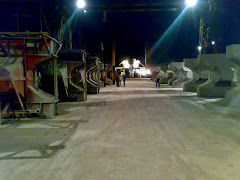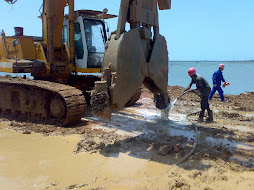In ports
one finds different types of structures to accommodate ships, such as quay
walls, wharfs, jetties, dolphins. Quay walls are in this respect one of the
most important assets for a port authority. For example in the Port of
Rotterdam, approximately 80 km quay walls is present. This implies that a
continuous search is going on to improve these structures. An overview of the
history within the Port of Rotterdam is presented.
Hambantota
port Jetties construction using caisson type retaining structures insitu
concreting.
Quay
walls are earth retaining structures at which ships can berth. They are
equipped with bollards and fenders, and they are used for the handling of goods
by cranes and other equipment moving alongside the ship. In ancient times ship landing
had been restricted to natural bays in which ships were drawn to the dry. At
places where ships could moor villages and towns grew up. Mooring places grew
into quays and developed into ports and trading places. Early types of quays
were gravity walls, their retaining function is obtained by the self weight of
the structure. Gravity walls have been constructed from stone blocks, since the
first century BC already from concrete.
Especially at coast lines with weak soils sheet pile
walls have been developed. They get their soil
retaining function and stability from the fixation
capacity of the soil. The sheet pile wall then is a
cantilever beam elastically fixed in the ground. With
increasing height the deflections at the top become
to large so that the top needs to be anchored. Once
more the fixation capacity of the soil is the
stabilization element for the anchors.































